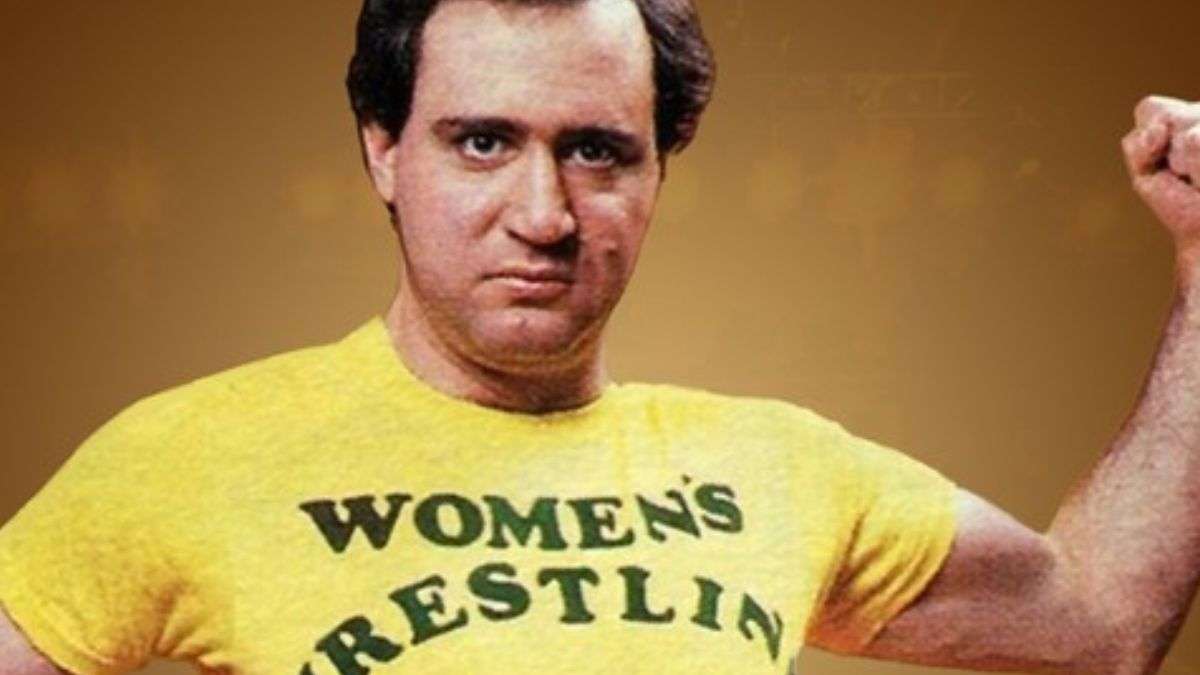Carrey’s ‘Man On The Moon’ a reminder of Kaufman’s genius
Starring: Jim Carrey, Danny DeVito, Courtney Love, Jerry Lawler
Written by: Scott Alexander, Larry Karaszewski
Directed by: Milos Forman
In some ways, Andy Kaufman’s incredible foray into the world of wrestling was as natural a fit as could be. Here was an artist whose primary tool for entertaining audiences was in blurring the line between what was real and what was trickery. Where else did he belong but in a wrestling ring? In that sense, Man on the Moon provides a perfectly conceived vehicle for Jim Carrey to bring Kaufman’s life to screen in the only truly appropriate fashion –- by blurring the lines.
It’s impossible to guess how Kaufman would have liked to see his life portrayed, and I’m not going to pretend to know him in the slightest to offer any kind of expert opinion. Still, consider this: Man on the Moon gives us real players from Kaufman’s past in Jerry Lawler, Judd Hirsch and David Letterman, playing themselves despite the years since passed. Bob Zmuda, Kaufman’s friend and creative partner-in-crime, is portrayed by renowned actor Paul Giamatti (Planet of the Apes (2001), Sideways), but the real Bob Zmuda has a different role in the film and is an executive producer. George Shapiro, Kaufman’s agent, plays a role other than himself in the film, while his character is portrayed by Danny DeVito, who chose not to portray himself in the scenes from Taxi. On top of all this, there’s the reportedly “real” feud between Jim Carrey and Jerry Lawler to consider. Getting a little muddled? That’s why I think Kaufman would have liked this film. It’s having fun with its players and not in a way that shows contempt for the audience.
Biographical films are often rightly criticized for using a “paint-by-numbers” approach in recounting a lifetime: anecdotal stories from a person’s youth and the end of their days sandwiched around re-creations of the famous times of their life, which usually comprise much of the movie. In other words, we spend a lot of time watching the material we’ve already seen. There’s a certain comfort in seeing the familiar. Man On The Moon, on the other hand, moves quickly through Kaufman’s Taxi and Saturday Night Live years and instead lingers on the more obscure of Kaufman’s ventures. His feud with Jerry Lawler is one of those ventures, and it is a significant part of the movie.
The script portrays Kaufman at wits’ end, trying to come up with a new way to shock his audiences. If you don’t know the story of Andy Kaufman, Intergender Champion, here is the film’s version in short. While watching wrestling on TV, he admires it as a form of “ballet”, and wishes he could be a heel, but Zmuda reminds him that at his size he could never legitimately step in the ring with any wrestler worth his salt. Kaufman is struck with an idea that takes Bobby Riggs and Billie Jean King’s “Battle of the Sexes” off the tennis courts and into the wrestling ring. Kaufman appears on The Merv Griffin Show and announces himself to be the Intergender Champion. He opens a challenge for any woman to pin him, and ensures he will have a challenger by outlining a woman’s strengths as laying mainly in the kitchen. His challenge is accepted by Lynne, played by Courtney Love (The People vs. Larry Flynt), and after resoundingly defeating her he takes his act to the next level. It also sparks an unlikely relationship with Lynne, who is with him until the end of his days.
It’s down in Memphis that Kaufman’s wrestling career takes off to greater heights than ever expected. Kaufman’s doing his usual short of work of taking down female volunteer wrestlers until a pro wrestler named Foxy Jackson is introduced as the next challenger. In reality, Jackson was a spectator who just happened to be quite good as a wrestler, and she nearly legitimately beat Kaufman. In the film, Jim Ross does the honours of announcing a match between the two for the Intergender Championship. It’s after Kaufman pulls off a victory in this match that Lawler gets involved, calling Kaufman out on his lack of respect for the wrestling business. The two of them meet in the ring, where the match turns into a one-sided beating down of Kaufman by side-suplex and piledriver. Kaufman is taken to the hospital and he and Lawler appear shortly thereafter on the David Letterman show, supposedly to put aside their differences. Halfway through their interview segment, Kaufman spews profanities at Lawler to the point that The King up and slaps Kaufman right out of his chair.
And that is where the movie closes up the chapter on Andy’s wrestling career. In truth, it actually carried on for a long time, with angles such as Andy and Lawler making peace and teaming up against Jimmy Hart before it was revealed as a double-cross plot created by Hart and Kaufman to attack Lawler yet again. In terms of the film, however, this would have been an unnecessarily lengthy timeline to represent. The wrestling life takes up a large part of the movie as it is, especially considering that Taxi is treated with a sort of “greatest hits” music video of Carrey re-creating scenes with the other original cast members set to the show’s theme, and Saturday Night Live receives an similarly truncated treatment. The wrestling world is shown to be smart, conscientious, and ultimately masterful at the art of trickery -– and Kaufman’s involvement was, like much of his material, well ahead of its time. He suffered severe backlash from mainstream audiences for his part in it years before the WWF and WCW would make celebrity involvement a regular occurrence. One might even say that Kaufman’s Intergender Championship paved the way for the glorious title reign of one David Arquette.
The feud between Lawler and Carrey left people, understandably, skeptical about its legitimacy. In his book It’s Good To Be The King … Sometimes, Lawler recounts how it started with Carrey insisting that he receive a piledriver from Lawler instead of the stunt double while filming their match. Lawler refused, rightfully fearing the wrath of Universal Studios who had already forbid Carrey to take the maneuver himself. As the shooting day came to an end, Lawler describes Carrey throwing a tantrum and saying Lawler was simply afraid to apply the hold. The “star from Hollywood” followed that up by spitting in Lawler’s face, and he received a headlock in return. “I think this was all a big plot of Jim’s … so he could say he had to be sent to the hospital at the hands of Jerry Lawler,” The King explains in his book. “History was repeating itself but this time, at least on my part, it wasn’t a work.” Believe that, of course, at your own risk.
Carrey’s performance has been praised for his uncanny portrayal of Kaufman, and he does deserve credit for just that. It’s the inclusion of Kaufman’s real-life peers, though, that really does the trick as far as knocking down the “fourth wall” and making us believe we are right there, watching events unfold for the first time. How surreal it must have been for those involved to attend the re-staging of Andy’s funeral service -– to be there with some of the same people and watching Carrey perform a farewell video at the service. The film has been criticized for not trying to provide answers as to why Kaufman acted the way he did, but it seems clear that their purpose was not to attempt any explanation. Instead, it is a celebration by imitation, and allows the audience to get caught up in the madness one last time.




